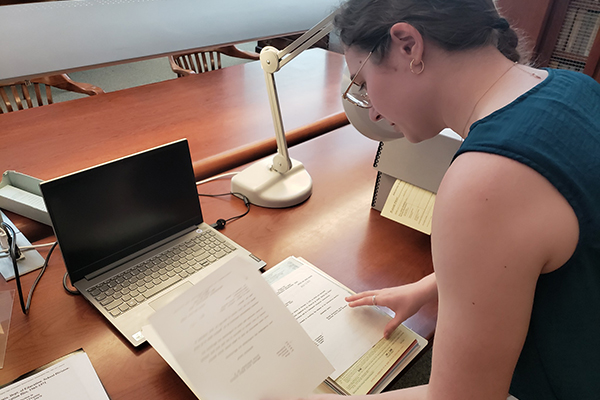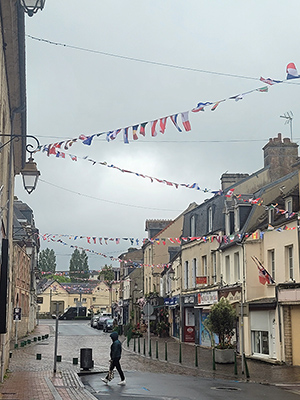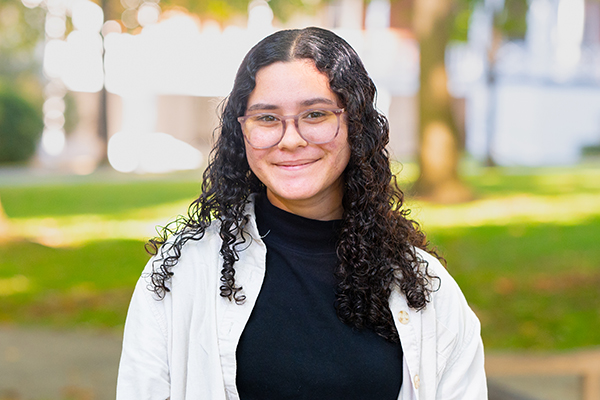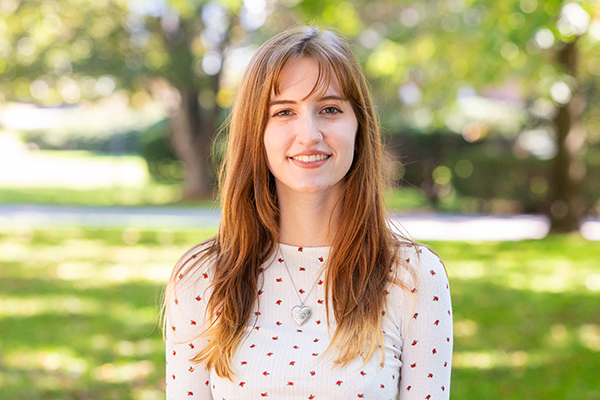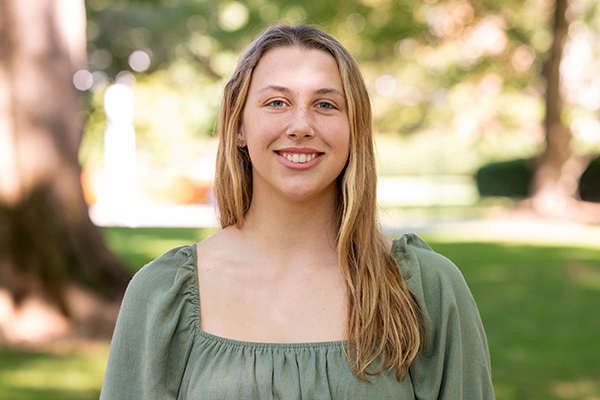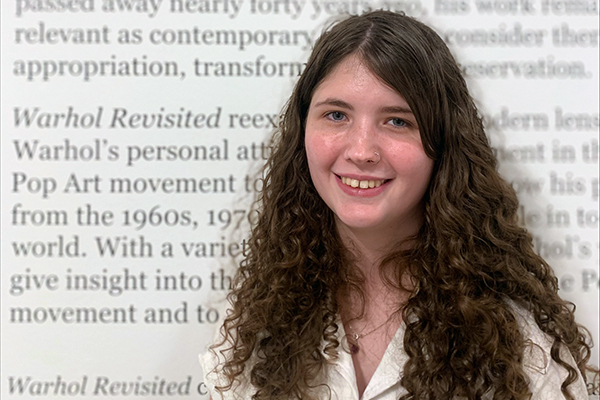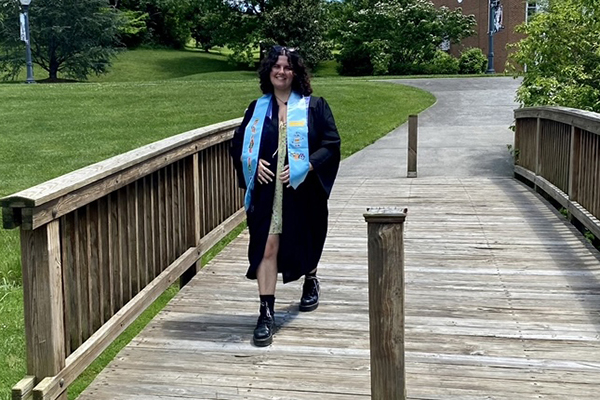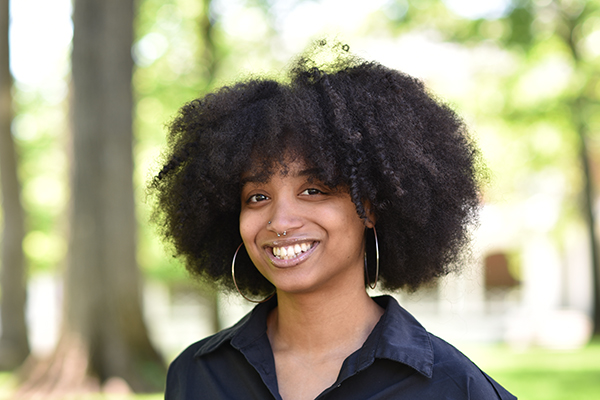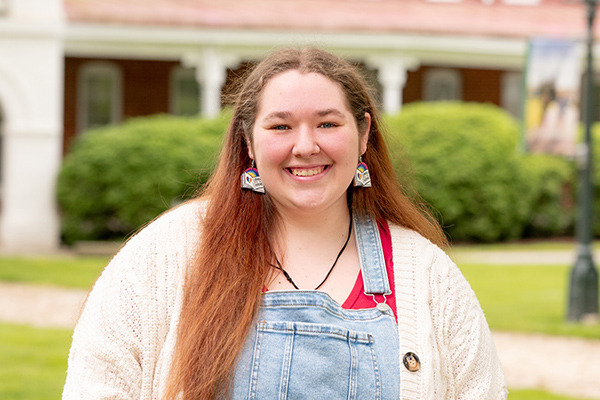This summer, history major Sophia Ciatti ’24 played a key role in bringing to fruition the very first exhibition of its kind at the Library of Virginia.
Ciatti, who hails from Bellingham, Washington, spent ten weeks interning with the library’s Outreach and Education division, where she conducted research for a project intended to spotlight Virginia’s 11 Indigenous tribes.
“In its history, I don’t think the library has ever produced promotional or educational materials related to any of the tribes, so I was very excited to have the opportunity to contribute,” Ciatti says.
Ruth Alden Doan Assistant Professor of History Christopher Florio first brought the Library of Virginia’s internship program to Ciatti’s attention. “He really goes out of his way to help students find different opportunities that might not be on their radar,” Ciatti explains. “The work that was listed for Outreach and Education represented what I want to pursue in the future, which is a mix of archival and museum work.”
Ciatti was aware of and interested in the Virginia Indigenous tribes exhibition, so she was delighted when the library offered her an internship this summer and the opportunity to support Outreach and Education on the project. During a typical day, her work consisted of three components. She spent the longest amount of time in the library’s archive reading rooms, where she immersed herself in interpreting original documents located in the Virginia Department of Education’s desegregation files. “My job was to look for, document, and catalog any record of Indigenous students – the counties in which they lived, the schools where they were enrolled, and they years in which they attended.”
Legislation passed in Virginia 99 years ago, which remained law in the commonwealth until it was overturned by the U.S. Supreme Court in 1967, was a significant challenge in Ciatti’s research. The Library of Virginia website notes that the 1924 Racial Integrity Act “was designed to stop the ‘intermixture’ of white people and Black people. The act banned interracial marriage by requiring marriage applicants to identify their race as ‘white,’ ‘colored,’ or ‘mixed.’”
The architect of the Racial Integrity Act was a physician and active proponent of the eugenics movement named Walter Ashby Plecker. “As the head of Virginia’s Bureau of Vital Statistics from 1912-1946, Plecker was responsible for ensuring that all infants born in Virginia received birth certificates that included their racial designation,” the National Park Service website explains. “Plecker used bureaucracy as a weapon against Black and Indigenous people across the state of Virginia.”
“Plecker made a hit list of specific Indigenous family names that he sent to coroners, midwives, census takers, basically everyone who was working with records,” Ciatti adds. “He said, ‘If you come across any one of these family names, you need to erase any sign that they are Native or Indigenous.’ It was unbelievable and truly evil.”
As a result, Ciatti found few records of Native students. “I had to analyze and compare between years. For example, by 1968 [after the Racial Integrity Act was overturned] the forms began showing Native students, so I could reasonably infer that the schools had Native students in 1966. That was the most complicated part, and it took up most of my time.”
After working about four hours each day in the archives, Ciatti would then spend another two hours searching through historic newspapers for mentions of the commonwealth’s Indigenous tribes. She focused on two publications: The Washington Post from the 19th century up through the modern day, and the Southern Workman, a monthly journal published by Hampton Institute from 1872-1939. In the latter, “I was looking for particular articles from the late 1870s when Hampton Institute accepted its first Native American students,” Ciatti says. “They had this wonderful column where the Native students could write about their experiences. I identified those for my supervisor, who could look at them more in-depth and figure out which perspectives she wanted to feature in the exhibit.”
The third aspect of Ciatti’s internship involved field research: she accompanied the exhibition project team on visits to tribal centers where they conducted in-person interviews regarding the library’s documents focusing on Indigenous peoples, such as a map created by 17th century English explorer John Smith that outlined the different tribal areas and lands.
“It was interesting to hear the different tribes’ perspectives on the map and other documents, including those from the era of the Racial Integrity Act, and how they reflected or didn’t reflect their own history that they kept,” Ciatti recalls. “Some of them used it as an opportunity to push back – ‘I’m Chckahominy. This is my identity and I’m not going to let you change it.’ I was fascinated to hear some of tribal members talk about how ‘they really wanted us to hide this part of ourselves. There was this horrible period of time where it was a bit too dangerous to reveal who we were, or just not socially accepted. I’m glad that now I get to do it. It’s safe for me to identify with my history and my culture.’”
Ciatti praises her internship supervisor, Community Outreach Specialist Ashley Craig, for her guidance this summer. “The specifics of this project and the research involved are all her ideas. She taught me how to do historical research in a way that you’re always looking for ‘what else,’ ‘what’s next,’ and ‘who’s missing’ in particular. I give her so much credit.”
Whether they are studying history, English, computer science, business, psychology, or other majors, Ciatti recommends that all undergraduates consider the Library of Virginia for internship opportunities. “There are many interesting and different projects available that aren’t related to history, and they are all truly fulfilling.”
Transitioning from her summer internship, Ciatti is now researching the economics of tourism in the states of Montana, North and South Dakota, and Wyoming for her senior honors thesis. Her mother grew up in Spearfish, South Dakota, so Ciatti is very familiar with the region’s major attractions, which draw heavily upon the mythmaking, imagery, and iconography of the Old West to financially survive.
“I think it’s incredibly interesting, for example, that the town of Wall, South Dakota, is almost entirely sustained by Wall Drug, the state’s number two tourist attraction after Mount Rushmore. That’s been the case for almost 90 years – it’s the sole economic reason why that town exists. I thought it would be fascinating to see how that developed and how these towns are able to grow in what is objectively the middle of nowhere in the U.S.A.”
After graduating from Hollins next spring, Ciatti plans to take one or two gap years to get valuable experience in archival, research, and data collection work before going on to pursue graduate studies. “I made a lot of excellent networking connections through the Library of Virginia internship that I will be utilizing,” she says. “There are plenty of ways to get involved, for example, in government work on both the federal and state levels. My professors and advisors have also recommended exploring opportunities with Americorps or the Peace Corps.”
Eventually, Ciatti hopes to complete a research-focused Ph.D. in museum curation and collection. “I plan on continuing my education as long as I can do it.”
Photo courtesy of the Library of Virginia



